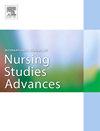Proposing a two-stage screening approach to distinguish between transient and enduring postnatal depressive symptoms: A prospective cohort study
IF 3.1
Q1 NURSING
International Journal of Nursing Studies Advances
Pub Date : 2025-01-04
DOI:10.1016/j.ijnsa.2024.100284
引用次数: 0
Abstract
Background
Screening for perinatal depression using the Edinburgh Postnatal Depression Scale (EPDS) improves detection and increases health service utilization. However, previous studies with antenatal samples indicate that positive screenings might reflect transient distress that resolves without intervention, raising concerns about over-pathologizing typical postnatal responses and inefficiencies in referral practices. Therefore, distinguishing between transient and enduring depressive symptoms for appropriate referrals to secondary services is crucial, highlighting the need for a refined screening practice.
Objectives
We aimed to assess the prevalence of transient distress among postnatal women who initially screened positive on the EPDS and evaluate the effectiveness of a refined two-stage screening approach. Three research questions were addressed: Can the "transient phenomenon" be replicated in a postnatal sample? Can initial screening data predict transient status? What are the implications of adopting a two-stage screening approach?
Methods
In a prospective cohort study, 427 postnatal women in Copenhagen who scored above the cut-off on their initial EPDS screening (EPDS-1) underwent a second screening (EPDS-2) 1–4 weeks later, without intervention in between. We analyzed the predictive power for transient versus enduring distress using EPDS-1 total scores, responses to item 10 ("self-harm item"), parity, maternal age, and a history of depression. Three screening scenarios were compared for their clinical and ethical implications: (i) a traditional single screening approach where all individuals screening positive at EPDS-1 are directly referred to secondary services, (ii) a simple two-stage approach where all positive screenings at EPDS-1 undergo a second screening before referral, and (iii) a refined two-stage screening approach where selected criteria determine immediate referral or further screening.
Results
Among women who screened positive, 29.3 % displayed transient distress with a clinically meaningful decrease in EPDS scores. An EPDS-1 score of 15 or more was the most robust predictor of enduring symptoms (OR = 6.28, 95 % CI 3.5–11.8; Absolute Risk = 90.4 %) and was used along with a positive score on item 10 as indicators of immediate referral in scenario-iii. The refined two-stage approach reduced unnecessary referrals by 24 %, directly referred 60 % of women with enduring symptoms, and effectively managed suicidal risk.
Conclusions
A substantial proportion of postnatal women experience transient symptoms that are distinguishable from enduring symptoms through a refined two-stage screening strategy. This approach significantly improves referral efficiency and minimizes over-pathologization, enhancing clinical practice in perinatal mental health.
求助全文
约1分钟内获得全文
求助全文
来源期刊

International Journal of Nursing Studies Advances
Nursing-General Nursing
CiteScore
5.80
自引率
0.00%
发文量
45
审稿时长
81 days
 求助内容:
求助内容: 应助结果提醒方式:
应助结果提醒方式:


